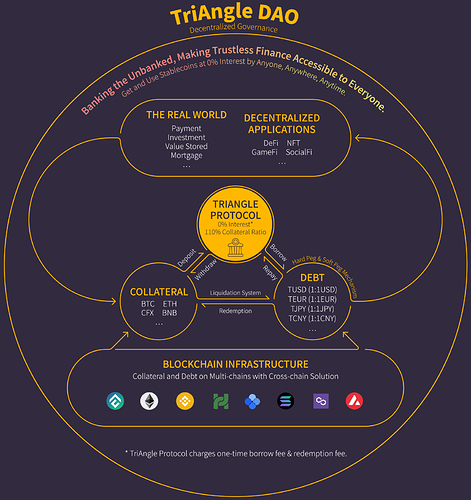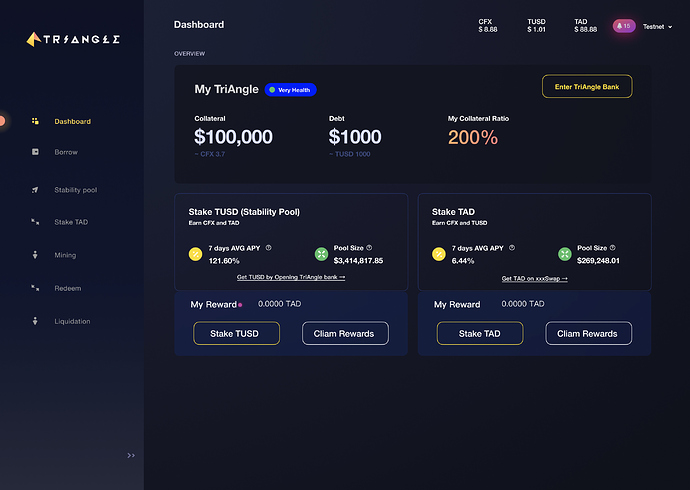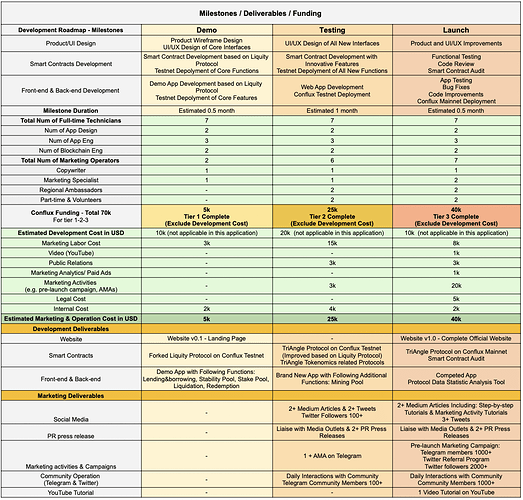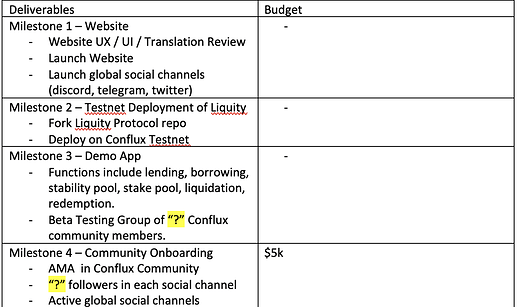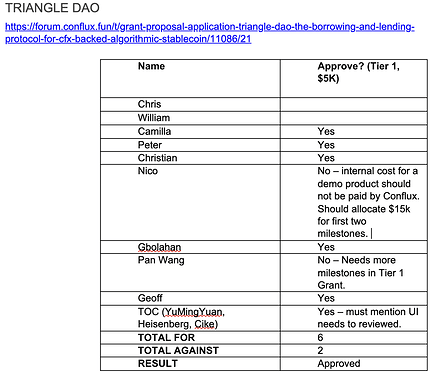1) Funding Tier:
Tier 1 - 3 whole development process: Funding amount requested - $100K
2) Project Overview
-
Project title and description of the project.
Project Title: TriAngle DAO (We hope that the TriAngle stablecoin AUSD exhibits the same stability, pressure-resistance, and ubiquity as its shape stands for.)
Project Description: TriAngle DAO is a globally accessible stablecoin protocol that provides stablecoins at 0% interest to anyone, anywhere, anytime, aiming to bank the unbanked people. Specifically on Conflux Network, it is a decentralized borrowing protocol offering interest-free liquidity via stablecoin AUSD against collateral in CFX. By utilizing a novel liquidation mechanism and leveraging an algorithmic monetary policy, it can offer unprecedented benefits for borrowers.
Project Slogan:
Banking the Unbanked, Making Trustless Finance Accessible to Everyone.
Get and use stablecoins at 0% interest. Anyone, anywhere, anytime.
-
How will this project be integrated into Conflux?
TriAngle DAO’s genesis launch will be on the Conflux Network, with USD-pegged stablecoin, AUSD (short for TriAngle USD) as Conflux’s first native stablecoin!
TriAngle token contract (AUSD issuance) and DAO contract (community governance voting schemes) will be deployed on the Conflux Network.
With the development of TriAngle DAO, AUSD will be launched soon in multi-ecosystems and be used in various scenarios among Conflux and outside-of-Conflux Dapp ecosystems to further incentivize liquidity migration to Conflux.
-
Why is your team interested in creating this project?
There are significantly large portions of global population remaining unbanked or underbanked. TriAngle believes every human being deserves equality, and has the right to enjoy the benefits of financial services fairly. With the blockchain, smart contracts and tokens, TriAngle DAO is eager to provide financial services of stablecoins to everyone, and eventually to construct a better financial world in a decentralized and sustainable way.
In terms of choosing Conflux Network, to be specific, there are three main reasons:
-
USD stablecoins are the fundamental assets of Conflux Ecosystem, especially for DeFi legos. There is a huge demand of USD stablecoins from Conflux community and Conflux Dapp projects. However, there aren’t many USD stablecoins circulating throughout the whole ecosystem. We believe a protocol-issued native stablecoin with crypto assets backed and an algorithmic mechanism would greatly benefit the Conflux Ecosystem.
-
The most circulated crypto asset and the most widely used cryptocurrency on Conflux Network is CFX. Due to the lack of usage scenarios, CFX holders are constrained in DeFi activities and are in demand of a practical solution to increase liquidity while holding CFX on hand. TriAngle believes CFX-backed stablecoins are able to address the situation.
-
In addition to the issuance of stablecoins, the reliability and stability of the protocol should also be taken into consideration. Among all borrowing and lending protocols in the market, “Liquity Protocol on Ethereum” is one of the most secured and well-designed protocols that support stablecoins. Thus, TriAngle takes "Liquity " model as prototype and further tailors features and mechanisms to better satisfy CFX holders’ needs.
3) Project Details:
-
High-level technical approach, product flow & architecture (along with a diagram).
-
Any mockup designs of user interfacing components.
The TriAngle team is working on product design and user interface design. Will upload updated snapshots later.
-
Overview of the technology stack being used, including API specifications, and documentation of core components.
Tech Stack used: Express Web Framework (Node.js) for back end, Vue.js (JavaScript) for front end, Solidity with ConfluxTruffle for contracts.
Smart contracts to be deployed on Conflux blockchain:
- Borrower (Trove) Operations: contains basic operations by which borrowers interact with their Trove: Trove creation, CFX top-up / withdrawal, stablecoin issuance and repayment
- TroveManager: contains functionality for liquidations and redemptions
- Stability Pool: contains functionality for Stability Pool operations: making deposits, and withdrawing compounded deposits and accumulated CFX and TAD gains. Holds the AUSD Stability Pool deposits, and the CFX gains for depositors, from liquidations.
- AUSD token: stablecoin token
- TAD token and Staking Functions: secondary token
-
Ecosystem fit: How can the project benefit Conflux Network’s ecosystem?
TriAngle stablecoin AUSD as a problem-solver benefits several parties:
-
CFX holders: In addition to increase liquidity and DeFi usage scenarios, CFX holders are able to earn rewards by participating in liquidity mining, stability pool and staking pool in TriAngle protocol, and most importantly they are free to withdraw all or part of their crypto assets anytime.
-
Crypto Investors: Crypto investors are able to rely on a stable currency to trade, pay, receive, and most importantly get out of price volatility of cryptocurrency.
-
DeFi Users: DeFi users are able to use a widely-accepted currency as medium of exchange to interact with DeFi Dapps.
-
Dapp Developers: Stablecoin is widely used in many DeFi Projects. Stablecoin AUSD is a great measure of value for all on-chain Dapps. Stablecoins can empower DeFi developers in all ways.
-
Conflux Ecosystem: The significance of stablecoins in the cryptoworld has been widely acknowledged, such as BUSD to Binance chain, ETH to Ethereum, and SOL to Solana. A native stablecoin plays a vital role in supporting on-chain ecosystem and on-chain crypto economy. In this case, Conflux’s first native stablecoins AUSD will enable Conflux users to easily participate in community activities, social events, airdrops, liquidity mining, etc., instead of going through a complex process of cross-chain stablecoins exchanges.
4) Team:
TriAngle DAO is proposed by a global-based decentralized autonomous organization. The core team and early contributors prefer to remain anonymous and firmly believe that a decentralized financial world should be initiated by a decentralized organization and further developed and governed by a Decentralized Autonomous Organization (DAO).
5) Development Roadmap:
6) Long Term Vision: What is the team’s long term vision for the project?
Building a better financial world with TriAngle.
- Financial Freedom
- Financial Efficiency
- Financial Transparency
- Financial Connectivity
TriAngle DAO is committed to providing decentralized financial services in stablecoins and banking the unbanked individuals. With a globally accessible stablecoin protocol, people everywhere can easily get and use stablecoins at 0% interest anytime.
Long Term Roadmap
- TriAngle meets Conflux(Deposit CFX as collateral to borrow AUSD)
- Deploy at multi-chains(e.g. Etherum, BSC, HECO, Polygon, Solana…)
- Support multi-crypto assets as collateral
- Apply crypto assets cross-chain solutions
- Hand over to DAO
7) Community Engagement:
TriAngle’s tutorials will be released to the Conflux community and to the public 2 weeks prior to the product launch date.
8) Delivery Requirements:
Github repositories are required for the delivery of your project, including test suites (e.g. integration tests if applicable) and will guide you on how to run the project.
GitHub: https://github.com/triangle-dao
9) Other:
Will provide TriAngle’s pitch deck later.

